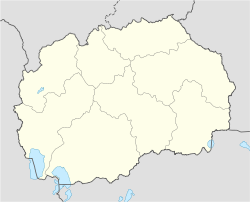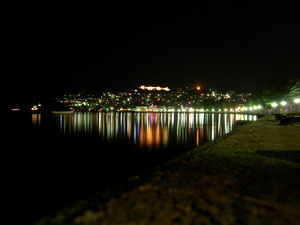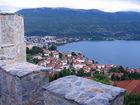Ohrid
| Ohrid Охрид |
|||
|---|---|---|---|
 |
|||
|
|||
| Nickname(s): Macedonian Jerusalem, European Jerusalem[1] | |||
 Ohrid
|
|||
| Coordinates: | |||
| Country | |||
| Municipality | Ohrid Municipality | ||
| Government | |||
| - Mayor | Aleksandar Petreski | ||
| Area | |||
| - Total | 383.93 km2 (148.2 sq mi) | ||
| Elevation | +695 m (2,280 ft) | ||
| Population (2002) | |||
| - Total | 42,003 | ||
| - Density | 142.97/km2 (370.3/sq mi) | ||
| Time zone | CET (UTC+1) | ||
| Postal codes | 6000 | ||
| Area code(s) | 389 46 | ||
| Patron saints | Saint Clement and Saint Naum | ||
Ohrid (Macedonian: Охрид, [ˈɔxrid]) is a city on the eastern shore of Lake Ohrid in the Republic of Macedonia. It has about 42,000 inhabitants, making it the seventh largest city in the country. The city is the seat of Ohrid Municipality. Ohrid is notable for having once had 365 churches, one for each day of the year and has been referred to as a "Jerusalem".[2][3] The city is rich in picturesque houses and monuments, and tourism is predominant. It is located southwest of Skopje, west of Resen and Bitola, and east of Elbasan and Tirana in Albania.
In 1980, Ohrid and Lake Ohrid were accepted as a World Heritage Site by UNESCO.
Contents |
Name
In Macedonian, and the other South Slavic languages, the name of the city is Ohrid (Охрид). In Albanian, the city is known as Ohër or Ohri. Historical names include the Latin Lychnidus[4] or the Greek names Lychnidos (Λύχνιδος), Ochrida (Οχρίδα, Ωχρίδα) and Achrida (Αχρίδα), the latter two of which are still in modern usage.
Geography
Ohrid is located in the south-western part of Macedonia, on the banks of Lake Ohrid, at an elevation of 690 meters above sea level.
History
The earliest inhabitants of the widest Lake Ohrid region were the Bryges and Encheleans. During the Roman conquests, towards the end of 3rd and the beginning of 2nd century BC, the Greek Dassaretae and the region Dassaretia were mentioned, as well as the town of Lychnidos. The existence of the ancient town of Lychnidos is linked to the Greek myth of the Phoenician prince Cadmus who, banished from Thebes, in Boetia, fled to the Enchelei[5] and founded the town of Lychnidos on the shores of Lake Ohrid [6].

The Lake of Ohrid, the ancient Lacus Lychnitis, whose blue and exceedingly transparent waters in remote antiquity gave to the lake its Greek name; it was still called so occasionally in the Middle Ages. It was located along the Via Egnatia, which connected the Adriatic port Dyrrachion (present-day Durrës) with Byzantium.According to recent excavations by Macedonian archaeologists it was a town way back at the time of king Phillip II of Macedon.[7] They allege that Samuil's Fortress was built on the place of an earlier fortification, dated to 4th century B.C.[7] Archaeological excavations (e.g., the Polyconch Basilica from 5th century) prove early adoption of Christianity in the area. Bishops from Lychnidos participated in multiple ecumenical councils.
The Bulgarians conquered the city in 867. The name Ohrid first appeared in 879. Between 990 and 1015, Ohrid was the capital and stronghold of the Bulgarian Empire[8]. From 990 to 1018 Ohrid was also the seat of the Bulgarian Patriarchate. After the Byzantine conquest of the city in 1018, the Bulgarian Patriarchate was downgraded to an Archbishopric and placed under the authority of the Ecumenical Patriarch of Constantinople.
The higher clergy after 1018 was almost invariably Greek, including during the period of Ottoman domination, until the abolition of the archbishopric in 1767. At the beginning of the 16th century the archbishopric reached its peak subordinating the Sofia, Vidin, Vlach and Moldavian eparchies, part of the former Peć Patriarchate (including Peć itself), and even the Orthodox districts of Italy (Apulia, Calabria and Sicily), Venice and Dalmatia.
As an episcopal city, Ohrid was an important cultural center. Almost all surviving churches were built by the Byzantines and by the Bulgarians, the rest of them date back to the short time of Serbian rule during the late Middle Ages.
Ohrid is credited as being the likely birthplace of the Cyrillic alphabet, which was most probably created by St. Clement of Ohrid that further reformed the Glagolitic alphabet created in turn by the brothers Saints Cyril and Methodius.
Bohemond and his Norman army took the city in 1083. In the 13th and 14th century the city changed hands between the Despotate of Epirus, the Bulgarian, the Byzantine and the Serbian Empires. At the end of the 14th century it was conquered by the Ottomans and remained under them until 1912. The Christian population declined during the first centuries of Ottoman rule. In 1664 there were only 142 Christian houses. The situation improved in the 18th century when Ohrid emerged as an important trade center on a major trade route. At the end of this century it had around five thousand inhabitants. Towards the end of the 18th century and in the early part of the 19th century, Ohrid region, like other parts of European Turkey, was a hotbed of unrest. Semi-independent feudal lords such as Mahmud Pasha Bushatlija and Djeladin Beg controlled Ohrid and openly defied the central government by not submitting taxes and by using tax money to bolster their own private armies. By the end of 19th century Ohrid had 2409 houses with 11900 inhabitants out of which 45% were Muslim while the rest was mainly Orthodox Christian. Before 1912, Ohrid (Ohri) was a township center bounded to Monastir sanjak in Monastir province (present-day Bitola).
| Natural and Cultural Heritage of the Ohrid region* | |
|---|---|
| UNESCO World Heritage Site | |
 |
|
| State Party | |
| Type | Mixed |
| Criteria | i, iii, iv, vii |
| Reference | 99 |
| Region** | Europe and North America |
| Inscription history | |
| Inscription | 1979 (3rd Session) |
| Extensions | 1980 |
| * Name as inscribed on World Heritage List. ** Region as classified by UNESCO. |
|
Ecclesiastical history
Its first known bishop was Zosimus (c. 344). In the sixth century it was destroyed by an earthquake (Procopius, Historia Arcana, xv), but was rebuilt by Emperor Justinian (527-565). The new city was made the capital of the prefecture, or department, of Illyricum, and for the sake of political convenience it was made also the ecclesiastical capital of the Illyrian or southern Danubian parts of the empire (southern Hungary, Bosnia, Serbia, Transylvania, Moldavia, Wallachia). Justinian was unable to obtain immediately for this step a satisfactory approbation from Pope Agapetus or Pope Silverius. The Emperor's act, besides being a usurpation of ecclesiastical authority, was a detriment to the ancient rights of Thessalonica as representative of the Apostolic See in the Illyrian regions. Nevertheless, the new diocese claimed, and obtained in fact, the privilege of autocephalia, or ecclesiastical independence, and through its long and chequered history retained, or struggled to retain, this character. Pope Vigilius, under pressure from Emperor Justinian, recognized the exercise of patriarchal rights by the Metropolitan of Justiniana Prima within the broad limits of its civil territory, but Gregory the Great treated him as no less subject than other Illyrian bishops to the Apostolic See (Duchesne, op. cit., 233-237).
The inroads of the Avars and Slavs in the seventh century brought about the ruin of this ancient centre of religion and civilization, and for two centuries its metropolitan character was in abeyance.
But after the conversion of the new Bulgarian masters of Illyria (864) the see rose again to great prominence, this time under the name of Achrida (Achris). Though Byzantine missionaries were the first to preach the Christian faith in this region, the first archbishop was sent by Rome. It was thence also that the Bulgarians drew their first official instruction and counsel in matters of Christian faith and discipline, a monument of which may be seen in the Responsa ad Consulta Bulgarorum of Nicholas I (858-867), one of the most influential of medieval canonical documents[9]. However, the Bulgarian King (Knyaz) Boris was soon won over by Byzantine influence. In the Eighth General Council held at Constantinople (869), Bulgaria was incorporated with the Byzantine patriarchate of Constantinople, and in 870 the Latin missionaries were expelled. Henceforth Byzantine metropolitans presided in Ohrid; it was made the capital of Bulgaria[10] during the rule of Samuil and profited by the tenth-century conquests of its warlike rulers so that it became the Metropolitan of several Byzantine dioceses in the newly conquered territories in the wider region of Macedonia , Thessaly, and Thrace. Bulgaria fell unavoidably within the range of the Photian schism, and so, from the end of the ninth century, the diocese of Ohrid was lost to Western and papal influences.
The overthrow of the Bulgarian empire in 1018 by Byzantine Emperor Basil II recovered Ohrid [11]. It became a seat of the Bulgarian Archbishopric of Ohrid. At a later date some of the great Byzantine families (e.g. the Ducas and the Comneni) claimed descent from the Emperors, or Cars, of Bulgaria. In 1053 the Metropolitan Leo of Ohrid signed with Michael Caerularius the latter's circular letter to John of Trani (Apulia in Italy) against the Latin Church. Theophylactus of Ohrid (1078) was one of the most famous of the medieval Byzantine exegetes; in his correspondence (Ep., 27) he maintains the traditional independence of the Diocese of Ohrid. The Bishop of Constantinople, he says, has no right of ordination in Bulgaria, whose bishop is independent. In reality Ohrid was during this period seldom in communion with either Constantinople or Rome. Towards the latter see, however, its sentiments were less than friendly, for in the fourteenth century we find the metropolitan Anthimus of Ohrid writing against the procession of the Holy Spirit from the Father and the Son. Yet Latin missionaries appear in Ohrid in the fourteenth and fifteenth centuries, mostly Franciscan monks, to whom the preservation of the Roman obedience in these regions is largely owing. In the thirteenth century, the noted judge Demetrios was archbishop of Ohrid.
Pursuant to Archbishop Arsenius II's petition, the Ecumenical Patriarch Samuel I had the see finally abolished as an autocephalous unit in January 1767 by an order of the Ottoman Sultan Mustapha III. At the height of its authority, Ohrid could count as subject to its authority ten metropolitan and six episcopal dioceses.
Buildings and museums (selection)
There is a legend supported by observations by Ottoman traveler from 15th century, Evlia Celebia that there were 365 chapels within the town boundaries, one for every day of the year. Today this number is significantly smaller. However during the medieval times, Ohrid was called Slavic Jerusalem[12].
- Church of St. Sophia
- Church of St. Panteleimon
- Church of St. John at Kaneo
- Church of St. Clement
- Church of St. George
- Church of St. Zaum
- Church of St. Naum
- Church of St. Petka
- Church of St. Stefan
- Vestiges of basilicas from the early-Christian time, e.g. Basilica of St. Erazmo (4th century)
- Museum of Slavic writing culture (18th century)
- Robevi family house, museum of archeology
- Antique Theatre
- Church of St. Vrači, with frescos from the 14th century. A 14th-century icon from the church is depicted on the obverse of the Macedonian 1000 denars banknote, issued in 1996 and 2003.[13]
Note: Besides being a holy center of the region, it is also the source of knowledge and pan-Slavic literacy. The restored Monastery at Plaošnik was actually one of the oldest Universities in the western world, dating before the 10th century.
There is a nearby airport, Ohrid Airport (now known as Apostle Paul Airport) that is open all year round.
Recurring events
- Ohrid Summer Festival, annual theater and music festival from July to August
- Ohrid Choir Festival, annual international choir festival in the end of August
- The Balkan Festival of Folk Songs and Dances, annual folklore music and dance festival in the beginning of July
- Balkan music square festival, music festival in August in which ethno musicians from the whole Balkan peninsular participate
- Ohrid Fest (Охридски Трубадури), music festival in August in which musicians from the whole Balkan peninsular are participating. This festival is held for four days which are divided into (Debutant Night, Folk Night, Pop Night and International Night).
International relations
Twin towns — Sister cities
Ohrid is twinned with:
|
|
Gallery
 View from the Lake |
 The Church of St. John at Kaneo high above the lake |
 Church of St. John at Kaneo |
|
 Samuil's Fortress |
Monument of saints Cyril and Methodius |
Church of St. John at Kaneo against Ohrid's panorama |
1000-year-old tree in Ohrid's old bazaar |
 View of the fortress and city |
St. Panteleimon at night |
See also
- List of people from Ohrid
- Ohrid Agreement
Notes
- ↑ Dnevnik newspaper - Interview with the ambassador of Israel to Macedonia (Macedonian)
- ↑ Between past and future: civil-military relations in post-communist Balkan states, Biljana Vankovska, Håkan Wiberg, I.B.Tauris, 2003, ISBN 1-86064-624-7, p. 71.
- ↑ "The Mirror of the Macedonian Spirit, Zlate Petrovski, Sašo Talevski, Napredok, 2004, ISBN 978-9989-730-38-2, page 72: "... and Macedonia in the Cathedral Church St. Sofia in the Macedonian Jerusalem — Ohrid..."
- ↑ Wilkes, J. J. The Illyrians, 1992,ISBN 978-0-631-19807-9,Page 273: "... The provincial capital Scodra and Dyrrhachium were seats of the metropolitans, and there were bishops at Lissus, Doclea, Lychnidus (Ohrid),
- ↑ Wilkes, J. J. The Illyrians, 1992,ISBN 978-0-631-19807-9,page 98,"the Illyrian Enchelei, the 'eel-men', whose name points to a location near Lake Ohrid"
- ↑ Wilkes, J. J. The Illyrians, 1992,ISBN 978-0-631-19807-9,Page 99:"... 99 victory would be theirs if they received Cadmus as king. After this had come about as foretold, Cadmus and Harmonia ruled over them and founded the towns of Bouthoe (Budva) and Lychnidus (Ohrid). ..."
- ↑ 7.0 7.1 "Culture — Republic of Мacedonia". www.culture.in.mk. http://www.culture.in.mk/story.asp?id=12676. Retrieved 2008-10-13.
- ↑ Old Hermit's Almanac by Edward Hays,1997,ISBN 978-0-939516-37-7,page 82: "... He sent word to Samuel, the ruler in the Bulgarian capital of Ohrid, that he was returning 15,000 of his prisoners of war. ..."
- ↑ Mansi, xv, 401; Hefele, Concilieng., iv, 346 sq.
- ↑ Bulgarian Folk Customs by Mercia MacDermott,1998,ISBN 978-1-85302-485-6,page 26: "... one of these brothers, Samuil, proclaimed himself Tsar, with his capital at Ohrid.
- ↑ Dialogos: Hellenic Studies Review by David Ricks,2001,ISBN 978-0-7146-8189-4,page 30,(By 1020 Basil had finally defeated Samuel and his son, and recovered Ohrid ..."
- ↑ City of Ohrid official web portal
- ↑ National Bank of the Republic of Macedonia. Macedonian currency. Banknotes in circulation: 1000 Denars (1996 issue) & 1000 Denars (2003 issue). – Retrieved on 30 March 2009.
External links
- The Pearls of Ohrid
- (Macedonian)e-Ohrid Portal
- Ohrid travel guide from Wikitravel
- Ohrid including information in English
- Ohrid Lake Macedonia 1958 - Kinoteka na Makedonija Ohridsko Ezero
- Municipality of Ohrid
- Ohrid Saint Paul the Apostole Airport
- Ohrid News
- "Ohrid Climate Guide". http://www.weather2travel.com/climate-guides/index.php?destination=ohrid.
- Attribution
 This article incorporates text from a publication now in the public domain: Herbermann, Charles, ed (1913). "Achrida". Catholic Encyclopedia. Robert Appleton Company.
This article incorporates text from a publication now in the public domain: Herbermann, Charles, ed (1913). "Achrida". Catholic Encyclopedia. Robert Appleton Company.
|
||||||||||||||||||||||||||
|
||||||||||
|
|||||||
|
|||||||||||||||||||
|
|||||

